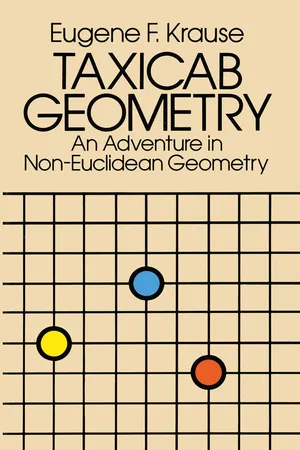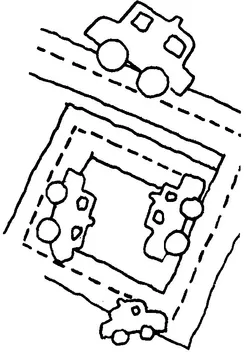
- 96 pages
- English
- ePUB (mobile friendly)
- Available on iOS & Android
About this book
This entertaining, stimulating textbook offers anyone familiar with Euclidean geometry — undergraduate math students, advanced high school students, and puzzle fans of any age — an opportunity to explore taxicab geometry, a simple, non-Euclidean system that helps put Euclidean geometry in sharper perspective.
In taxicab geometry, the shortest distance between two points is not a straight line. Distance is not measured as the crow flies, but as a taxicab travels the "grid" of the city street, from block to block, vertically and horizontally, until the destination is reached. Because of this non-Euclidean method of measuring distance, some familiar geometric figures are transmitted: for example, circles become squares.
However, taxicab geometry has important practical applications. As Professor Krause points out, "While Euclidean geometry appears to be a good model of the 'natural' world, taxicab geometry is a better model of the artificial urban world that man has built."
As a result, the book is replete with practical applications of this non-Euclidean system to urban geometry and urban planning — from deciding the optimum location for a factory or a phone booth, to determining the most efficient routes for a mass transit system.
The underlying emphasis throughout this unique, challenging textbook is on how mathematicians think, and how they apply an apparently theoretical system to the solution of real-world problems.
Frequently asked questions
- Essential is ideal for learners and professionals who enjoy exploring a wide range of subjects. Access the Essential Library with 800,000+ trusted titles and best-sellers across business, personal growth, and the humanities. Includes unlimited reading time and Standard Read Aloud voice.
- Complete: Perfect for advanced learners and researchers needing full, unrestricted access. Unlock 1.4M+ books across hundreds of subjects, including academic and specialized titles. The Complete Plan also includes advanced features like Premium Read Aloud and Research Assistant.
Please note we cannot support devices running on iOS 13 and Android 7 or earlier. Learn more about using the app.
Information
1 WHAT IS TAXICAB GEOMETRY?




Table of contents
- Dover Science Books
- Title Page
- Copyright Page
- about this book
- about the author
- materials
- TO THE TEACHER
- Table of Contents
- 1 WHAT IS TAXICAB GEOMETRY?
- 2 SOME APPLICATIONS
- 3 SOME GEOMETRIC FIGURES
- 4 DISTANCE FROM A POINT TO A LINE
- 5 TRIANGLES
- 6 FURTHER APPLICATIONS TO URBAN GEOGRAPHY
- 7 SOME DIRECTIONS FOR FURTHER RESEARCH
- APPENDIX - taxicab geometry and euclidean geometry compared
- SELECTED ANSWERS
- INDEX